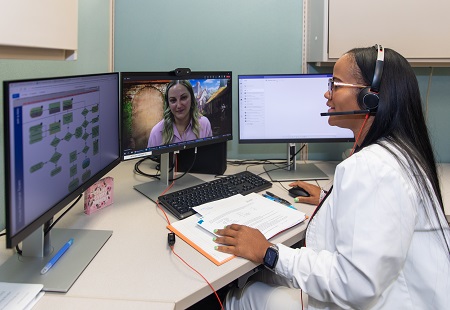After launching Cleveland Clinic Hospital Care At Home℠ (HCAH) in April 2023 to serve patients requiring acute hospital care at Cleveland Clinic Indian River Hospital in Vero Beach, Cleveland Clinic has expanded the program to Cleveland Clinic Tradition Hospital, Cleveland Clinic Martin North Hospital and Cleveland Clinic Martin South Hospital. Cleveland Clinic is now exploring the next phase in the multihospital expansion.
“The way we deliver care today is not how we will deliver care tomorrow,” says Richard Rothman, MD, Chief Medical Operations Officer for Cleveland Clinic in Florida and Vice Chief of the Integrated Hospital Care Institute for Cleveland Clinic. “Cleveland Clinic Hospital Care At Home is a glimpse into the future of healthcare delivery.”
Model of care
Patient eligibility to be hospitalized at home is based on a complete medical evaluation and determined in either the Emergency Department or within one of the hospital’s inpatient units. “Individuals who meet the criteria are offered the choice to receive hospital-level care at home or in a traditional hospital setting,” says Dr. Rothman, noting they must live within a 30-mile radius of the hospital to participate.
Once admitted, patients are set up at home with technology to enable transmission of biometric data, bidirectional communication, and coordination with the hospital’s Clinically Integrated Virtual Command Center (CIViC) located in Vero Beach. The CIViC team is comprised of physicians, advanced practice providers, and nurses who are responsible for directing patient care.
“Our specially trained caregivers are supported by a technology platform that organizes the patient’s data and care plan into actionable real-time information shared by the patient’s entire medical team,” Dr. Rothman explains. “We also have a network of internal and external clinical service providers who deliver care within the patient’s home.”
Early success
Cleveland Clinic Hospital Care At Home admitted 27 patients in its first month, double the average of validated peer benchmarks. By the end of its first 10 months, nearly 700 patients had been admitted. “That represents the elimination of nearly 2,000 brick and mortar hospital days since April,” says Dr. Rothman. “Following the opening of the virtual hospital at Indian River Hospital, the daily census averaged seven patients.”
Today, the virtual hospital census ranges from 17-20 patients and admission volumes exceed 120 per month. These patients had reduced readmission rates to the hospital and an improved patient experience. “The patient feedback has exceeded the already high bar we set for the virtual hospital,” says Dr. Rothman. “Our Press Ganey patient experience scores surpassed those for in-hospital care while having similar medical illness severity levels, and the readmission rate trends are to-date significantly lower for Hospital Care At Home than the brick and mortar hospital (9.6% versus ~13%).”
The HCAH team cares for patients with exacerbations of their chronic conditions such as chronic heart failure and chronic obstructive pulmonary disease; and diagnoses such as sepsis, cellulitis, pneumonia, influenza, COVID-19 and diverticulitis, among other conditions.
Enterprise expansion
Having completed the rollout of Cleveland Clinic Hospital Care At Home at Tradition Hospital in Port St. Lucie, and Martin North Hospital and Martin South Hospital in Stuart, the Cleveland Clinic is evaluating further expansion in Florida and Ohio.
Key learnings
Cleveland Clinic Hospital Care At Home is part of a larger national movement that includes nearly 300 hospitals across the country. Developed in the United States in the mid-1990s, the care model gained traction when the Centers for Medicare and Medicaid Services (CMS) launched the Acute Hospital Care at Home program in November 2020 in response to the COVID-19 pandemic.
According to Conor Delaney, MD, PhD, President, Cleveland Clinic Florida Market, the tripartite goal for Hospital Care At Home is to improve outcomes for patients, provide a better care environment for caregivers, and create a more sustainable healthcare delivery model for all.
“Our hospitalist-led approach has demonstrated positive early results, an indication we are on the right path,” says Dr. Delaney. “I have to commend our hospital medicine and nursing teams for guiding the successful implementation of Hospital Care At Home.”
While two years of planning with key clinical, operational, financial, and information technology stakeholders preceded hospitalizing the first Cleveland Clinic patient at home, Dr. Rothman notes the team still encountered foreseen and unforeseen obstacles that required them to be adaptable and “to think big.” Drs. Rothman and Delaney published these key learnings in the Journal of Hospital Medicine dated February 7, 2024.
Dr. Rothman shared some of the key learnings from the launch that may guide others ready to implement this model of care.
- Build trust among hospitalists, consultants, and ancillary staff by being transparent about the rationale of changing the standard of care for hospital medicine and continuously sharing quality data.
- Work with stakeholders to create well-defined home-based acute care pathways equivalent to those for common diagnoses managed in brick-and-mortar settings.
- Standardize patient screening practices and encourage clinicians to introduce the option of hospitalization at home early in care planning discussions.
- Communicate the value of the care model for frontline caregivers, including the patient-centeredness of care that promotes more meaningful interactions, a better understanding of patients’ needs, a rebalancing of the caregiver’s day, and overall improved job satisfaction.



























